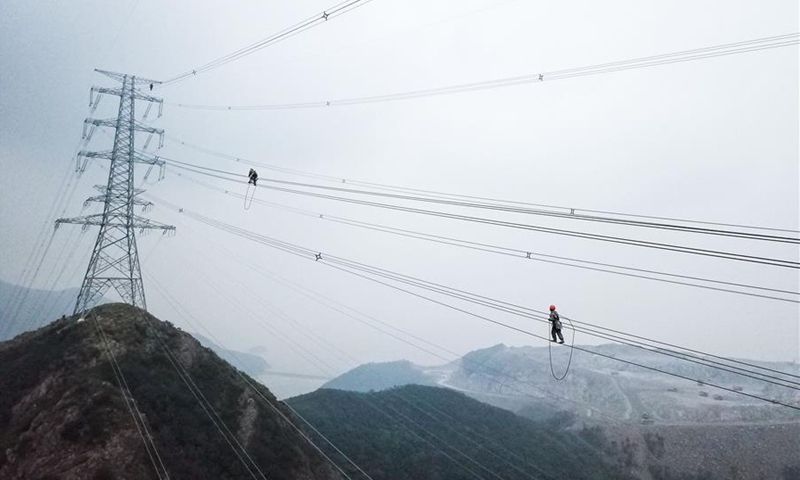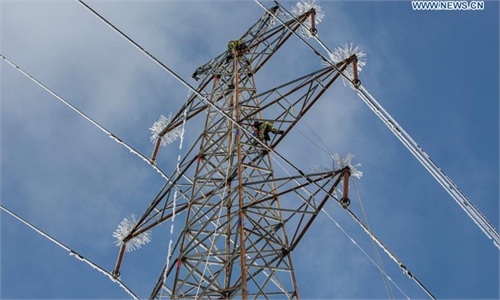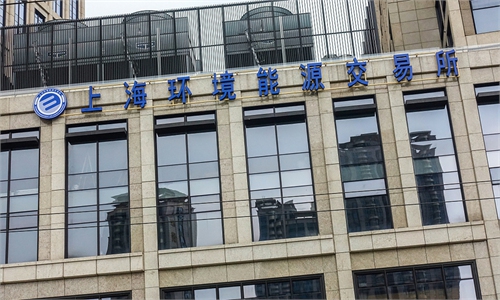State Grid vows to ensure power demand for livelihood needs
Challenges emerge but China not facing an 'energy crisis'

Aerial photo shows technicians of State Grid Zhejiang Electric Power Company checking power transmission lines to make sure the stable operation of local power supply in Zhoushan, east China's Zhejiang Province, Oct. 23, 2020. (Xinhua/Xu Yu)
The unexpected and unprecedented power cut in three provinces in Northeast China - Heilongjiang, Jilin and Liaoning - on Monday following reported electricity shortages have resulted in major disruptions to the daily lives of people and business operations, sparking growing concerns over the potential disruption of power supplies as demand booms ahead of the upcoming winter season.
Power rationing in some parts of Northeast China, particularly in some residential communities without advance warning, has sparked public anger and growing debate over China's power supply. Some have questioned if the recent power cuts are an indication of a potentially large domestic gap in power supplies that could lead to an "energy crisis."
While the power restrictions revealed many problems, including increasingly short supplies amid surging demand and prices as well as lack of coordination and execution by local officials, industry insiders sought to give assurances that the events were caused by multiple factors, including high coal prices, historically high demand and power cutting measures, but "China's energy supply capacity is so far adequate for meeting demand and that China has no energy crisis."
In response to the power cut, the State Grid Corp, a major operator of electricity networks in China, on Monday pledged to ensure basic electricity demand for people's daily consumption are met and power cuts are avoided to the best of their abilities.
The National Grid said that it is strengthening the unified dispatch of the entire power network, including exploiting the power transmission potential of inter-regional and inter-provincial channels.
The power curb in the three provinces in Northeast China made it onto the hot search list of China's Sina Weibo, a Twitter-like social media platform, on Monday, drawing around 500 million viewers and over 230,000 comments as of press time.
From Thursday onward, power rationing during peak hours occurred in many parts of Northeast China, including Shenyang, Changchun and other cities, after the region's entire power grid was in danger of collapse, according to media reports.
The lack of electricity has not only restricted industrial production, but has also had some impact on local residents, the Global Times learned.
Some netizens said that the power outage lasted for three days, and there was no signal on mobile phones, while some media reports showed that traffic lights on the main roads of Shenyang, capital city of Liaoning, could not operate normally, and some shops could only operate with candles.
Furthermore, potential contamination caused by blast furnace gas reportedly took place on Sunday in a steel production company in Liaoning after regional power was cut, causing 23 injuries, media reported on Monday.
Analysts said that blackout in residential areas should not be regarded as a form of power control, and even less so as the "dual control" goal on the country's total energy consumption and intensity, which is the broad consensus from civil society to the government.
This is actually a game between central and local governments, a macroeconomy analyst, who declined to be named, told the Global Times on Monday.
"The 'dual energy control' target has been implemented for many years. As far as I know, this year's implementation has been the strictest and there is no room for negotiation. Local governments may have been anticipating some relaxation of energy consumption quotas in an effort to bolster economic growth. But in fact, the central government is very determined to achieve the dual carbon goal and achieve green development," the macroeconomist said.
China's top economic planner, the National Development and Reform Commission (NDRC), published on August 12 a record of the achievements in "dual control" targets by province and region for the first half of 2021.
The findings serve as a wake-up call for local governments in achieving energy consumption and intensity reduction goals, and have been likened to "a student finishing his assignment right before the deadline." Achieving "dual control" targets has affected local economic performances, resulting in some resistance from local governments, Zhang Xiaorong, director of the Beijing-based Cutting-Edge Technology Research Institute, told the Global Times on Monday.
He also mentioned that coal prices are soaring while electricity prices are not, which means that power plants are not willing to produce electricity as every kilowatt of power produced results in a loss.
"Due to the lack of energy control and upgrading in the early stages, as the assessment of the central government approaches, some local governments took extreme measures, including restricting residential electricity consumption," the macroeconomist noted.
The power cut has not only occurred in Northeast China, but also dozens of other provinces including East China's Jiangsu and South China's Guangdong, manufacturing hubs for much-needed products around the world, especially since the COVID-19 pandemic began.
Jiangsu and Guangdong both fared badly on NDRC's barometer, failing to achieve both energy consumption and intensity reduction targets.
A textile factory in Jiangsu received a notice to cut power completely from mid-September to early October, in what could be one of the longest power cuts for the company, a manager told the Global Times on Monday.
The power cut has caused 500 workers to go off work in a month-long paid time off, and orders for both domestic and overseas markets have been rescheduled or canceled, the manager said, indicating that the potential losses for the company could be huge.
Other measures include supporting power generation enterprises, which experts said could be an indication of possible subsidies to power plants to help them ease the cost of high coal prices, as high coal prices have become a disincentive factor for generating more power.
Statistics showed that China has abundant electricity supply, with installed power generation capacity reaching 2.2 billion kilowatts.
"The challenge for China is that demand for electricity is increasing, but so are efforts on 'double control' and 'dual carbon' goals. But it just reflects the strong momentum and vitality of China's economic growth after the COVID-19 epidemic, as well as the huge efforts China has made on carbon emissions," an industry insider in the new-energy sector surnamed Qi told the Global Times on Monday.
According to data released by the NDRC, from January to August in 2021, electricity consumption in China totaled 5.4704 trillion kilowatt-hours, up 13.8 percent year-on-year, the largest growth since 2003.
Achieving China's "dual carbon" goals is a broad and profound systemic, economic and social change that will have huge impact on the current economic growth rate and structure, said analysts.
"The adjustment of energy structure should be an orderly and stable process that will surely take time. It can't be done in a short period of time. That's why China has set the target of reaching carbon peak by 2030 and carbon neutrality by 2060," Qi remarked.
In the decade from 2010 to 2020, the share of coal consumption in China's total energy consumption dropped from 69.2 percent to 56.7 percent, while the proportion of clean energy consumption increased from 13.4 percent to 24.4 percent, according to statistics from the National Energy Administration (NEA).
China ranks first in the world in terms of scale of renewable energy development and utilization, and China has built the world's largest clean energy generation system, Guo Zhi, chief economist of NEA, said on Sunday at the Zhongguancun Forum.
As of July, China's installed non-fossil energy capacity reached 1.03 billion kilowatts, including 380 million kilowatts of hydro power, 290 million kilowatts of wind power, 270 million kilowatts of solar power and 53.26 million kilowatts of nuclear power, said Guo.
"At present, the use and distribution of electricity in China is basically decided by local governments. Since the marketization of the national economy is very high, the lack of connection between the two systems will definitely lead to some inefficiency and confusion, and solving this big contradiction should be the main direction of our efforts to improve the efficiency of electricity use," an energy sector insider told the Global Times on Monday.
He noted that electricity prices should be graded according to consumption, just as tax is, and that there is huge space for adjustment of off-peak electricity.
The NDRC issued a document in July to establish a peak electricity pricing mechanism, stating that peak price should be at least 20 percent more expensive than the basic price.
Analysts urged Chinese authorities to establish an electricity system that is efficient, people-oriented, easily adjustable, and strong enough to prevent systemic risks.
Amid the electricity shortage, some have claimed that the disruption of trade with Australia could be one of the reasons for the tightened supply, speculation that has been denied by industry insiders.
Australian coal accounts for only 3 percent of total coal consumption in China, the Global Times learned from several industry insiders.
"Two-thirds of the shortfall of Australian coal has been made up by increased imports from Indonesia, South Africa and the US. At the same time, coal imports accounted for less than 10 percent of the total coal consumption in China. The fundamental reason for the coal gap is a result of surging domestic demand and carbon reduction controls," an industry insider told the Global Times on Monday on condition of anonymity.
China suspended imports of Australian coal from October 2020, so it is ridiculous to say that the shortage is a result of the absence of Australian coal, the insider said.
Given the big picture of China's aim of cutting carbon emissions and upgrading industry, the proportion of imported coal in total energy consumption will only shrink further, experts said.


